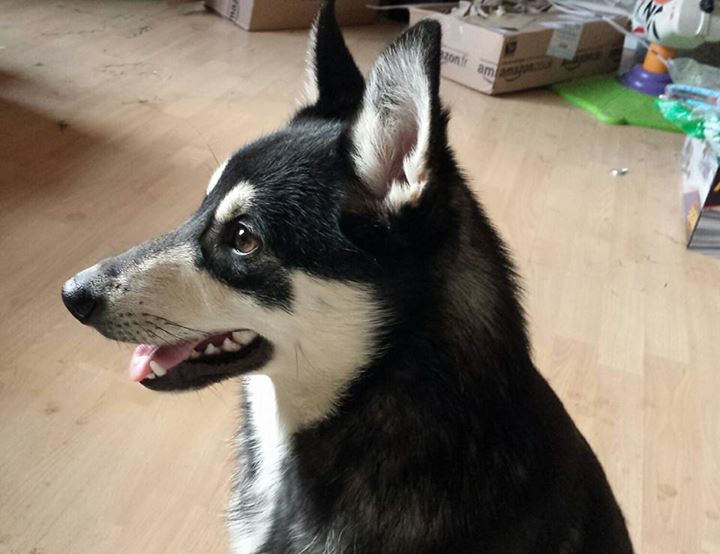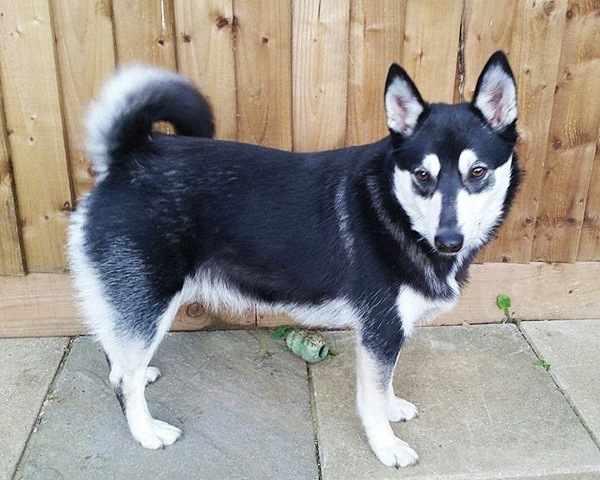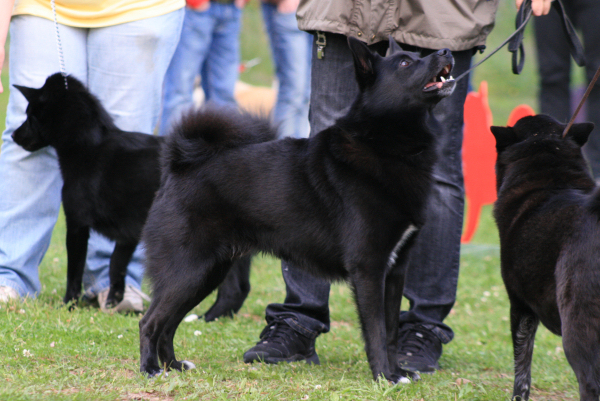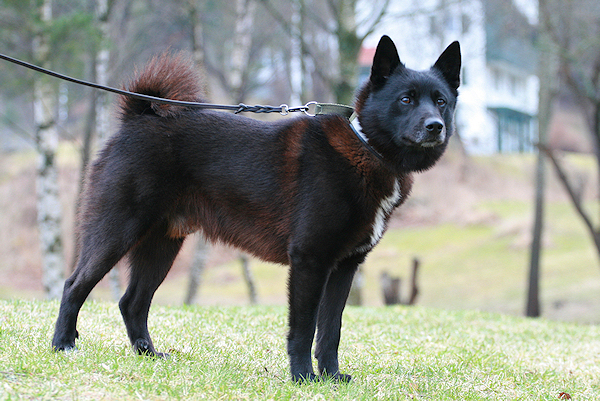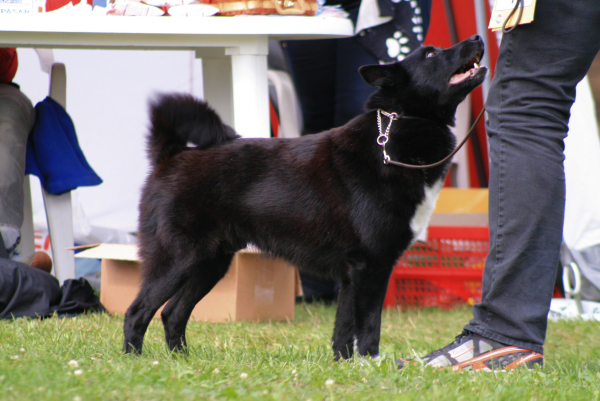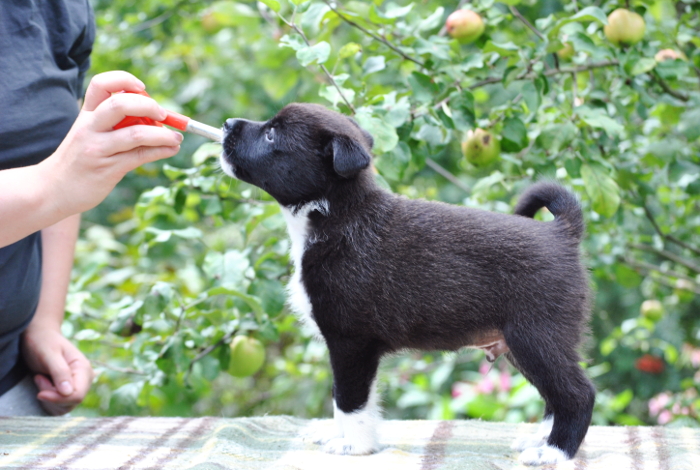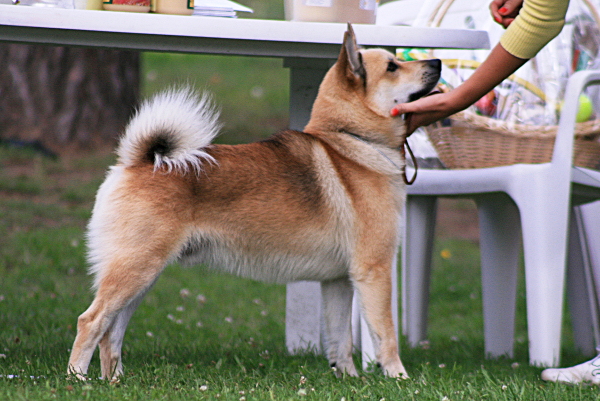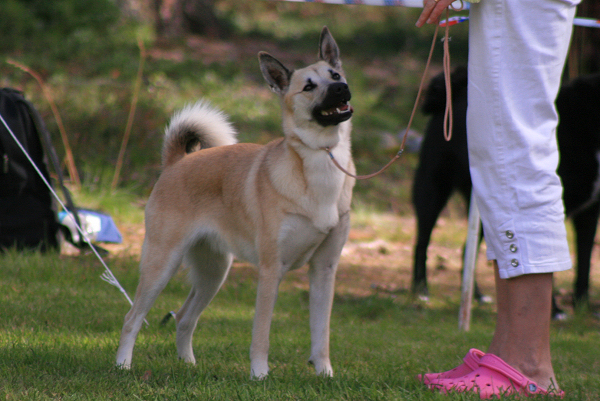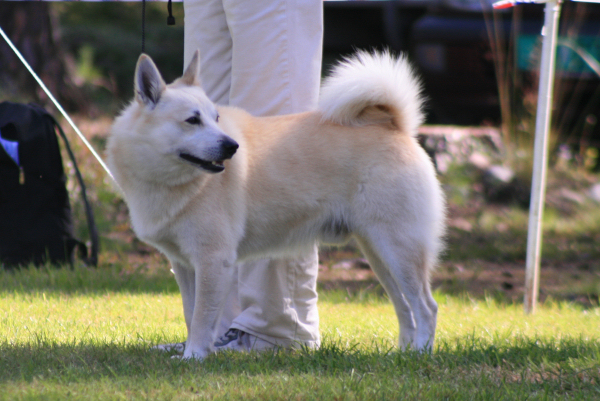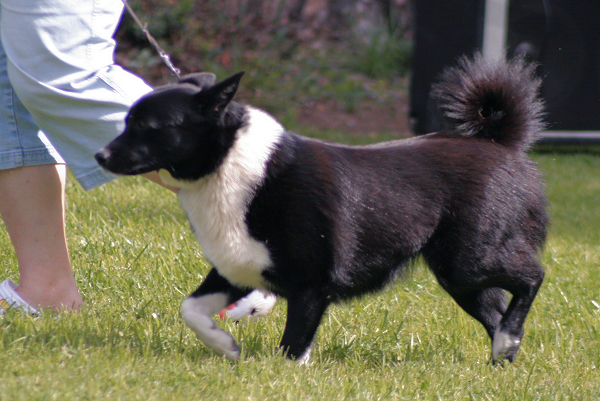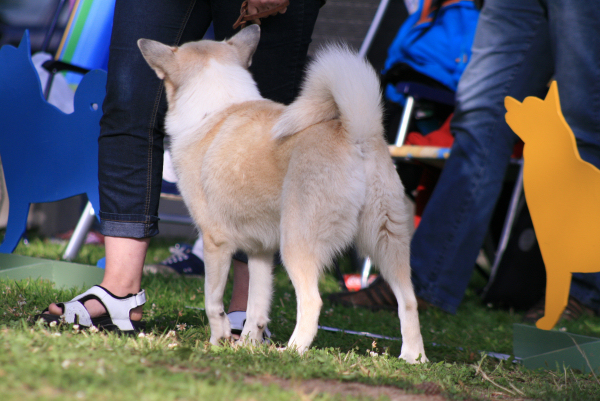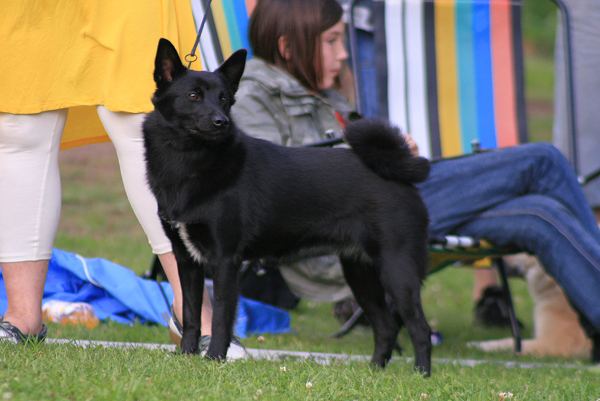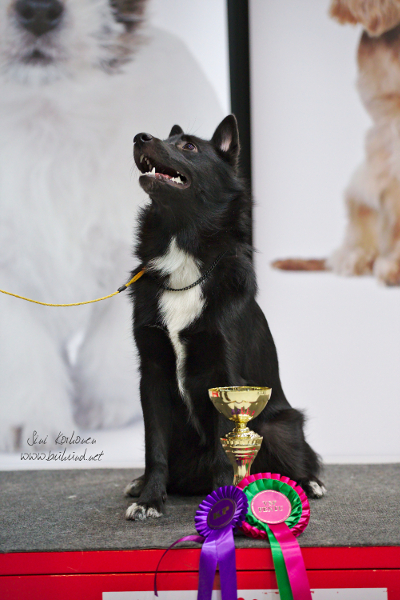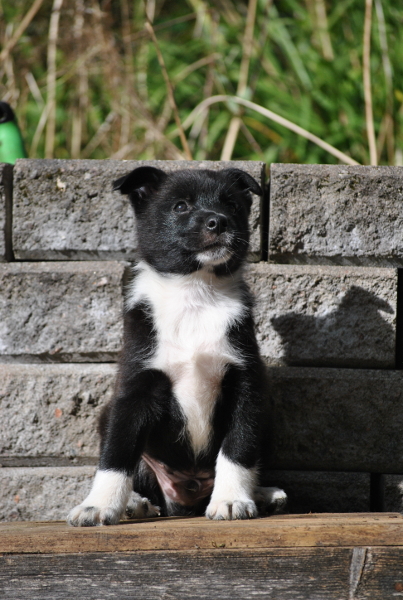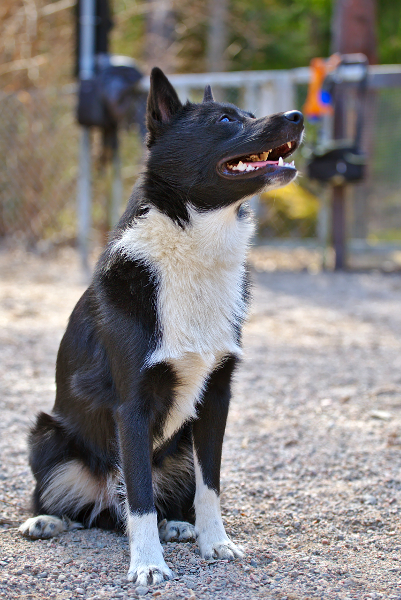Buhund genetics
Buhunds don't have many allowed colors / patterns so the basics of their color genetics are easy to learn. Relevant color loci for buhunds are K, A, E and S.At the end of the page you can also find genetics for fur lenght and hind dewclaws.
I won't be going trough all the different terms used here. Hopefully pictures will tell enough. I also encourage everyone to learn more from different sources if this gets you interested. There is a lot more to learn!
To different loci I will use letters that have the same meaning worldwide and some of them even apply straight to other animals. For example rats and mice have the same recessive black as dogs have and the letter combination for it is the same; aa.
Big thanks to everyone who sent me pictures and let me use them here!
A-locus, Agouti
| AyAy + AyAy (sable + sable) |
Sire: AyAy |
Dam: AyAy |
Puppies: 100% AyAy  |
For buhunds there is only one accepted A-locus pattern, Ay. Ay is "dominant yellow" or sable. Most buhunds are homozygote for sable but sometimes also other patterns of A-locus occur. Other alleles for A-locus are w (wolf color, wild color), t (tan-point) and a (recessive black). There is also the saddle pattern which is related to t-allele of A-locus but its exact working mechanism is unknown.
The patterns of A-locus don't always completely cover the more recessive allele (incomplete dominace).
Ay = The most dominant allele of A-locus, yellow
Aw or A = Recessive for y-allele and dominant for t and a -alleles, wild type
At = Recessive for y and w -alleles, dominant for a-allele, tanpoint
Aa or a = The most recessive allele of A-locus, agouti
Dominant yellow / sable of buhunds is also called blakk, gul, keltainen, cream, varglett, wheaten and shaded wheaten. They all refer to this same sable color.
When you cross two homozygote sables (most of the wheaten buhunds) there will be a whole litter of sables. A simple graph can be found a bit more up the page.
The intensity of pheomelanin varies a lot from light cream to dark mahogany red. Sable buhunds are often from the light end of the scale, even the "red" ones. Genes/gene for color intensity differences are not known. This means the inheritance cannot be explained with one pair of genes but for guidelines you could say: "the lighter the color, the more recessive it is".
Sable dogs always have some black somewhere on their fur. It could possibly be just one black-tipped hair on tail, but for buhunds it's most of the time more than that. Black-tipped hairs on a sable dog's fur are known as shading.
Sometimes buhunds with lots of shading are born and they are (mistakenly) called wolf sable or varglett. Actually wolf sable is a completely different allele of A-locus, Aw, and there is no evidence of real wolf sable in buhunds. The reason for dark shading could possibly lay in piling modificator-genes that regulate the amount of black tipped hairs. So the more a dog has these modificator-genes, the more it will have shading.
Another explanation for strong shading in buhunds is incomplete dominance of y-allele in Ayat -dogs. Some of the strongly shaded buhunds could possibly be carriers for tan-points.
Also light areas on body are characteristic for sable pattern. These light areas are positioned to ventral side of body (underside of muzzle and head, throat, belly, rump, underside of the tail). This is called countershading and strongness of it can also vary. Some dogs have a very big contrast between ventral and dorsal sides and some dogs look almost unicolored. Buhunds have everything in between. In Japanese breeds this strong contrast between countershading and other pheomelanin-colour in fur is called urajiro.
- Reddish, clear sable
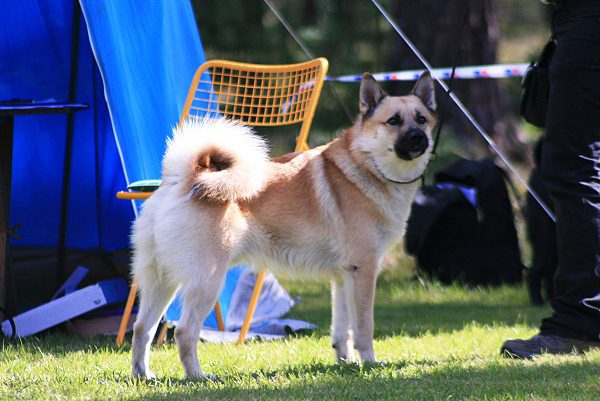 Amyrica's Tarek von Bjeff
Amyrica's Tarek von Bjeff
© Sini Korhonen - Light, clear sable
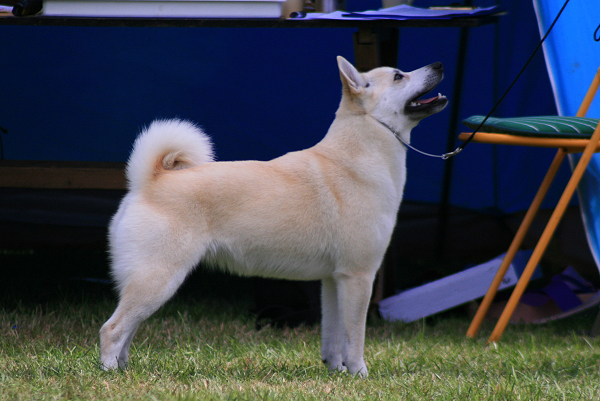 Kimura's Gurina
Kimura's Gurina
© Sini Korhonen - Strongly red clear sable
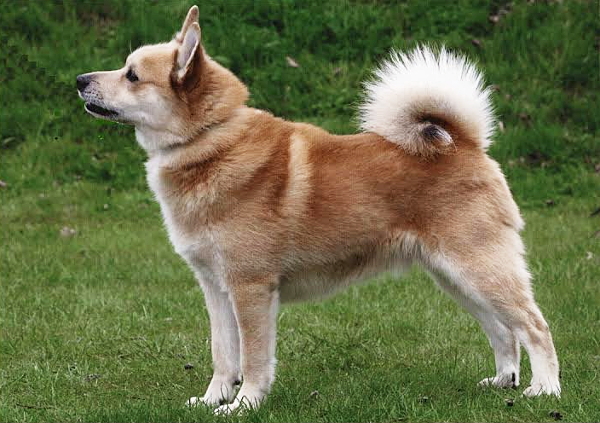 Gungner's Freke
Gungner's Freke
© Ritva Lindström - Shaded reddish sable
 Riverview MPW Britt Thunderpaws
Riverview MPW Britt Thunderpaws
© Lynn Higgins - Very strongly shaded sable
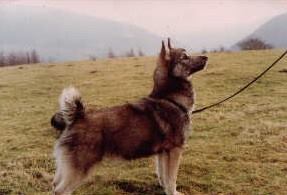 Blaidd Bach
Blaidd Bach
© Millie Pentland - Extremely shaded sable
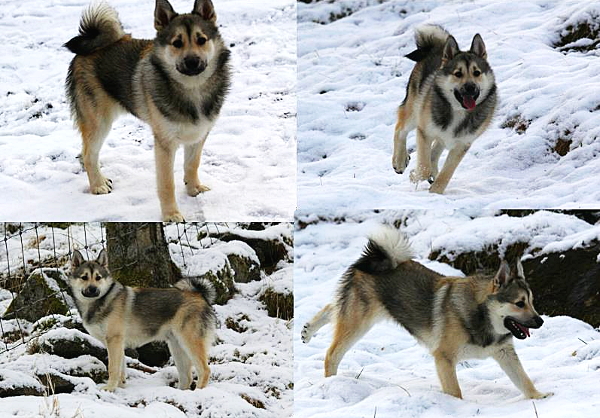 Vixir's Bobby McGee Baldersson
Vixir's Bobby McGee Baldersson
© Bente Kolbeinsvik
atat (tan-point)
| Ayat + Ayat (sable + sable) |
Sire: Ayat |
|
Dam: Ayat |
||
| Puppies: | ||
25% AyAy |
25% atat |
|
50% Ayat  |
||
Tan point is recessive to sable so both parents must be tan point carriers to have tan point -puppies. Breeding between tan point and sable will result in a whole litter of sables who carry tan points.
A tan pointed dog can also have an eumelanin mask (Em) and this makes the according parts of facial pheomelanin blanketed with eumelanin (usually black).
Tan point buhunds are mostly from Great-Britain. This is because one or more of their original imported buhunds was a carrier and the imported ones were used to breeding a lot. This made more carriers and eventually the carriers were bred together. It is possible that some or most of the "wolf sable" buhunds have truly been carriers of tan points. Such dogs are often much more shaded than normal sables. You can't know this for a fact without a gene test so this is only speculation.
atat + ? (saddle)
| KyKy E_ atat Sat_ + ? |
 |
I have even seen fairly recent pictures of buhunds with saddles. Because saddle can only be seen on atat -dog, there is no way of knowing which ones of our dogs would be saddled and which classic tan points if they were atat.
Saddle patterned puppy is usually born looking a lot like regular tan point but when the puppy ages the eumelanin pattern reduces in size.
Theories of saddle pattern have been many:
- atat + an allele working only with at-allele in some other locus (f.e. csa)
- There is an allele as in A-locus for saddle pattern (but gene tested saddle patterned dogs have all been atat or ata in A-locus)
- At the moment the best theory is atat + several partly unknown modificator genes which affect the size of eumelanin pattern.
One possibly identified part of this puzzle is in 5th intron of RALY-gene. All tested saddle patterned dogs had RALY +/+ (no duplicate, "wild" allele) or +/dup. (wild allele + duplicate allele) but never dup./dup. (2 duplicate alleles).
BUT. Any classic tan point could have any of these combinations so this finding does not solve the whole puzzle.
Bends straightened you could mark saddle pattern for example with Sat and sat -(imaginary) alleles when saddled dog would be Sat/Sat or Sat/sat but never sat/sat.
K-locus, blacK
| Heterozygote black + heterozygote black | |||
| KbKy + KbKy | Sire: KbKy |
||
Dam: KbKy |
|||
| Puppies: | |||
25% KbKb |
25% KyKy |
||
50% KbKy |
|||
| Heterozygote black + heterozygote black | |
| KbKb + KbKb | Sire: KbKb |
Dam: KbKb |
Puppies: 100% KbKb  |
| Homozygote black + sable | |
| KbKb + KyKy | Sire: KbKb |
Dam: KyKy |
Puppies: 100% KbKy  |
| Homozygote black + heterozygote black | |||
| KbKb + KbKy | Sire: KbKb |
||
Dam: KbKy |
|||
| Puppies: | |||
50% KbKb |
50% KbKy |
||
| Heterozygote black + sable | |||
| KbKy + KyKy | Sire: KbKy |
||
Dam: KyKy |
|||
| Puppies: | |||
50% KbKy |
50% KyKy |
||
KB = The most dominant allele in K-locus, black
Kbr = Recessive for B-allele and dominant for y-allele, brindle
Ky = The most recessive allele in K-locus, yellow
Kb and Ky
K-locus black blankets the pattern of A-locus. Letter markings for dominant black are Kb or K (informally).
Ky (alias k) shows the pattern of A-locus. So a buhund can be KbKb (black), KbKy (black) or KyKy (shows A-locus pattern. Sable for most buhunds).
Charts under the K-locus header show all the possible combinations of allowed colors when one or both parents are black. Just click the circle with combination inside to see it.
You can't know if the dog is KbKb or KbKy just by seeing it. If both parents are black, only offspring or gene test can tell us which alleles the dog has. A black buhund with one sable and one black parent will always be KbKy.
Dominant black dog can also be a "seal", "puppy-seal" or "bronzed".
- Seal or seal black refers to a phenomenon when the A-locus pattern partly shows trough dominant black. This can create very beautiful "ghost" patterns to a dog. Some seals have a black dorsal stripe. It is speculated that the seal dogs are always heterozygote dominant blacks (KbKy) but the complete working mechanism is not known. Seal can appear almost black in color or almost brown.
- There is also a form of seal black that only puppies can have. It looks more like bronzing than seal black and the puppy will grow up to be a regular black. It is not known why some puppies are seal black.
Both of the seal-variations are found in the breed.
- Bronzed black is a black with bronzing in its fur. Amount of bronzing can vary depending on reason. Some of the reasons include: diet, shedding, worn out fur (rubbing collar etc.) or sun. Bronzed, brown fur only changes color after the bronzed hair is shed and a new black hair is grown in its place. It is highly possible that genetics play a part in how suspectible the fur is for bronzing.
B, D and E -loci can sometimes change the eumelanin pigment to another color than black or remove it altogether. B changes the pigment to brown; D scatters and piles the pigment granules making the pigment seem blue; and E removes all the black / eumelanin from the fur leaving only yellow / pheomelanin.
These alleles are completely lost or very rare in buhunds.
E-locus, Extension
| EEm + EEm (mask + mask) |
Sire: EEm |
||
Dam: EEm |
|||
| Puppies: | |||
25% EmEm |
25% EE |
||
50% EEm |
|||
| EEm + EE (mask + no mask) |
Sire: EEm |
||
Dam: EE |
|||
| Puppies: | |||
50% EEm |
50% EE |
||
| EmEm + EEm (mask + mask) |
Sire: EmEm |
||
Dam: EEm |
|||
| Puppies: | |||
50% EmEm |
50% EEm |
||
| KBKy EmEm + KyKy EEm (black + mask) |
Sire: KBKy EmEm |
||
Dam: KyKy EEm |
|||
| Puppies: | |||
25% KBKy EEm |
25% KBKy EmEm |
||
25% KyKy EEm |
25% KyKy EmEm |
||
| KBKy EEm + KyKy EEm (black + mask) |
Sire: KBKy EEm |
|||
Dam: KyKy EEm |
||||
| Puppies: | ||||
25% KBKy EEm |
12,5% KBKy EE |
12,5% KBKy EmEm |
||
25% KyKy EEm |
12,5% KyKy EE |
12,5% KyKy EmEm |
||
- Eg, domino or grizzle, a gene that works only if the dog is wolf sable or tan point and is only found in certain breeds. - Eh which is a "cockerspaniel sable", a gene that is only found from cockerspaniels (or cockerspaniel crosses) and it only works on dominant black with tan point genes (Kb- at-) - And then there is the recessive yellow, e.
Em = Most dominant allele of E-locus, mask
Eg = Recessive to m-allele, can be shown only when the dog is also tan point or wolf sable, grizzle
Eh = Recessive to m-allele. Works only when dog is tan point and possibly also dominant black, hypomorphic
E = The "normal" or "wild" allele of E-locus, Extension
e = The most recessive allele of E-locus, recessive yellow, extension
Em - mask
Usually the masks of buhunds are not very large. At largest they only reach to cause black bases for ears and a black muzzle. As puppy the mask can be a big and very visible but it often shrinks or even disappears almost completely when the puppy grows. So an adult Em-dog (masked) can look very much like EE (no mask).
Mask is visible for almost every pattern of A-locus, but best it shows in sable. Even dominant black dog can have a mask but it just can't be seen (because the dog is obviously all black).
White muzzle markings can also hide the mask beneath them.
Em is dominant so the dog needs only one Em-allele to have a black mask. Basically it works completely the same as dominant black (compare the charts, their structure is the same!)
The mask is of eumelanin. This means that if there is B or D -locus changing the eumelanin pigment, also the mask color changes. bb would make brown mask, dd would make blue and bb dd lilac. Only a black mask is allowed for buhunds.
There is a gene test for Em and E -alleles if you want to know if your dog is genetically masked or not or if your masked dog is heterozygote or homozygote to Em.
ee-yellow
| KbKb AyAy ee + KyKy AyAy EE (sable + sable) |
Sire: KbKb AyAy ee |
Dam: KyKy AyAy EE |
Puppies: 100% KbKy AyAy Ee  |
There have also been cases of buhunds registered "white". Recessive yellow is a possible reason for these puzzling "white" buhunds.
Charasteristics of recessive yellow include light pawpads, light whiskers, partly meat-color nose and complete absence of black hairs. Only the last one is true to (almost) all ee-yellow dogs.
ee-yellow is not completely stable mutation so sometimes there are single black hairs or small black patches. They can be anywhere and often look out of place.
Recessive yellow carriers do not differ from non-carriers but there is a gene test for this color too.
S-locus, Spotting
| Ssi + Ssi (solid + solid) |
Sire: Ssi |
||
Dam: Ssi |
|||
| Puppies: | |||
25% SS |
25% sisi |
||
50% Ssi |
|||
| KBKy Ssi + KyKy sisi (black solid + sable irish) |
Sire: KBKy Ssi |
||
Dam: sisi |
|||
| Puppies: | |||
25% KBKy Ssi |
25% KBKy sisi |
||
25% KyKy Ssi |
25% KyKy sisi |
||
| SS + sisi (solid + irish) |
Sire: SS |
Dam: sisi |
Puppies: 100% Ssi  |
The third allele of S-locus is Sp which causes large (or not-so-large) white spotting over the body, "piebald".
S = The most dominant allele of S-locus, Spotting
Si = Recessive to S-allele, dominant to p, irish
Sp = Recessive to S and i -alleles, piebald
S and si
sisi causes the dog to have more or less white spotting. Often this includes white collar, white chest, paws, belly and tail tip ("collie markings"). Sometimes irish spotted dogs also have a white stripe on their head. All of these typical irish spotting markings might not always be in a genetically irish spotted dog. They could possibly only have a largish chest spot or white chest and half a collar.
In buhunds the half collars are more common than full collars, but collars in general are not seen very often. White head-stripes are rare but you can see them from time to time.
For a buhund it is considered a fault to have large white markings but even large white spots can blend in with sable color when the dog grows and the color gets clearer. Black buhunds don't have this advantage and the white markings can clearly be seen from birth to death. Only when the black dog starts to grey, some small white spots can blend in with the greying.
S makes the dog solid color, though "solid" in this case can be a bit misleading word. Genetically SS dog can very well have white markings on toes and chest. Real solids are actually rarer in buhunds than solids who have some white somewhere. It does not mean it is irish spotted or carries irish spotting. It just means the colour pigment didn't stretch just far enough when the dog was a developing puppy.
Usually if the dog has less than 10% of white in its body, it is considered solid.
The flexible range of white creates a problem when you're trying to decide if the dog is solid or irish white. Especially with large chest spots it might be impossible to know whether the dog is genetically SS, Ssi or sisi.
Spotting is inherited apart from all other loci and it is also visible in almost any dog pattern or color (aside from very light / almost white ee-yellows). So it does not matter if the other parent is solid black and other irish white sable, there can be irish white blacks as well as irish white sables in the litter.
Some possible combinations and their results are again introduced in charts.
T-locus, Ticking
| Heterozygote ticking + non-ticked | |||
| Tt + tt | Sire: Tt sisi |
||
Dam: tt sisi |
|||
| Puppies: | |||
50% Tt sisi |
50% tt sisi |
||
T = Dominant allele, ticked
t = Recessive to T-allele, non-ticked
Possibly also "Tr" = Dominant to t-allele, dominance to T is not known. Roaning.
T- and tt
T-allele makes little spots on the white areas of the dog. The spots are always the same as the base color (sable or black on buhunds) The size of the spots can vary from only a few colored hairs to clear spots. The amount of spots varies too.Ticked dog will also have a spotted skin.
It is possible that T is incompletely dominant, which would mean that a dog with Tt would only be little bit ticked and a dog with TT would have stronger ticking.
Ticking is an interesting gene since it only shows on white spotted dogs. Solid can also have the genes for ticking but it just can not be seen. This means it is not possible to know ticked dogs from non-ticked if they don't have white spotting that would show the ticking. A little bit of extra challenge comes from the fact that ticking is usually very hard to see on sable dogs.
Ticked puppy will have pure white spots when it is born and the ticking starts only when the puppy ages. At 8 weeks a puppy might have some visible ticking already but if it is only mildly ticked, it's possible there won't be any visible ticking at that age.
Ticking starts from toes and muzzle and if the dog is mildly ticked these areas can be the only areas to show ticking. So a pure white chest spot on a black dog is not a definite way to know if the dog is spotted or not.
From my own experience the first clear indicator of ticking, is darkening of the toes. When the puppy grows there will be more and more ticking on the toes and eventually the ticking spreads to legs and possibly to chest. Color appearing in the middle of white areas is a good sign of ticking. Normally pigment can only spread to the edges and make white markings smaller but this does not cause ticking-like pattern.
Chart shows a combination where one parent is heterozygote ticked and one is non-ticked. Most of the buhund combinations are probably like this because seeing ticking on buhunds is not very commong. However ticking is a normal dominant gene and works exactly like dominant black etc.
Special cases ll, split-face and bb
During the years there have been some buhund-looks that are not allowed in the breed standard today. Some of these you can still rarely see in buhunds, so here I introduce some other genes that affect the looks of a dog
| Ll + Ll (l-carrier + l-carrier) |
Sire: Ll |
||
Dam: Ll |
|||
| Puppies: | |||
25% LL |
25% ll |
||
50% Ll |
|||
L (length)
For long-haired puppes to be born, both parents must be carriers or show the trait. Crossing a carrier to non-carrier you get 50% of carriers (Ll) and 50% of normals (LL).
Long-haired buhund looks a lot like long haired icelandic sheepdog. They can have a huge amount of long fur or just some furnishings and a bit longer fur. It varies a lot.
Some of the l-carriers have a bit longer fur than LL-dogs, but you can't always tell the difference. Buhunds can have differences at fur-length even without the l-allele, so it might be impossible to know if they are carriers or not. Gene test can be made to achieve some amount of certainty.
Roots of long-haired gene in buhunds possibly lay at least in old icelandic sheepdog crossings. Also the open breed-register might have brought some carriers during the years.
| KbKy AyAy Bb + KyKy AyAy Bb (black + sable) |
Sire: KBKy AyAy Bb |
|||
Dam: KyKy AyAy Bb |
||||
| Puppies: | ||||
25% KbKy AyAy BB |
12,5% KbKy AyAy Bb |
12,5% KbKy AyAy bb |
||
25% KyKy AyAy BB |
12,5% KyKy AyAy Bb |
12,5% KyKy AyAy bb |
||
B-lokus (brown)
Usually the difference between black and brown is very clear but sometimes the brown pigment can be so dark you can't tell it from black if you don't have a black one to compare it with.
B-locus has at least three different known alleles for brown color. The end products of all of them are quite alike. Usually all of them are marked with just "b" because it is rarely relevant to know which alleles the dog has. The alleles get their names from the way they create the brown pigment:
B = The most dominant allele of B-locus, pigment does not change, Brown
bs = Recessive brown, stop
bd = Recessive brown, delete
bc = Recessive brown, cysteine
b would change a black buhund to completely brown. This is not the same thing as bronzing, a brown dog is born brown and is never black. If you have doubts, just look at the nose and eyes. A black bu (even bronzed black) has a black nose, usually very dark eyes and black eye-rims..
The chart shows a combination of a dominant black which carries heterozygote brown and a brown carrier sable.
Brown carriers cannot be distinguished from not carriers without a gene test.
It is possible that buhunds don't have brown at all. There are some buhunds that are registered as "brown" but they might be just puppy-seal, not real brown.
| SF/Sf + SF/Sf (stripe + stripe) |
Sire: SF/Sf |
||
Dam: SF/Sf |
|||
| Puppies: | |||
25% SF/SF |
25% Sf/Sf |
||
50% SF/Sf |
|||
Split-face
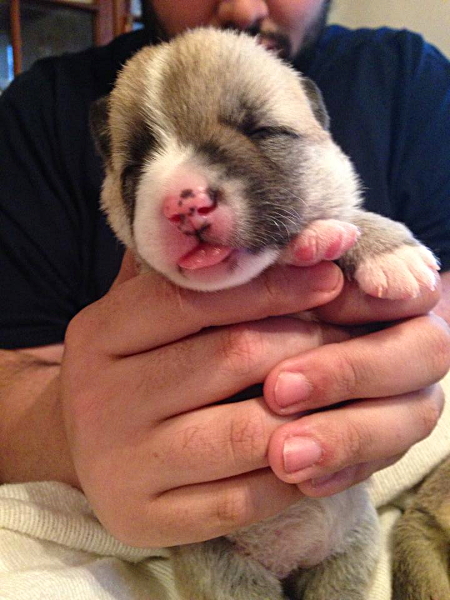 Homozygote split face usually has a big white splotch on the other side of head or otherwise lots of white on head. Split face also increases the amount of white on chest and neck. A very clear example of a split face is one of the grand-uncles of buhunds; Rapp Bjelland.
Homozygote split face usually has a big white splotch on the other side of head or otherwise lots of white on head. Split face also increases the amount of white on chest and neck. A very clear example of a split face is one of the grand-uncles of buhunds; Rapp Bjelland.
Heterozygote split face can often be mistaken for irish white. Common markings are for example white head stripes (especially wide or irregularly shaped) and wide collars (especially those which rise from neck towards head). Smallest split face patterns might only contain a wide spot on muzzle or some white on chin. There might be a reason to suspect split face especially if the head and neck markings are combined with small / non-existent socks on forepaws.
In itself the split face is not a dangerous pattern for a dog to have, but large white markings near ears might cause deafness (one or both ears) and possibly make one or both eyes blue.
Split face is not as such a disqualifying fault for a buhund but it will lower the grade in shows.
Hind dewclaws
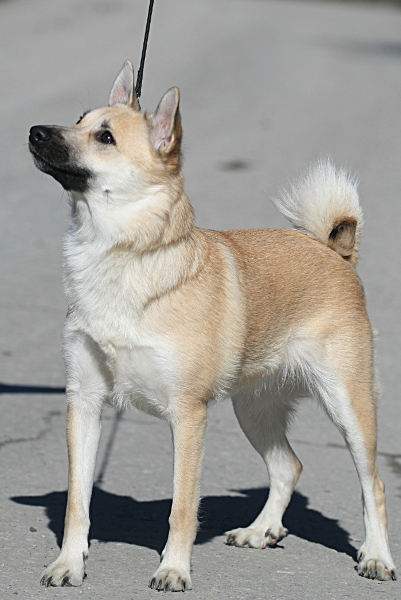 Hind dewclaws are a common trait in buhunds. There have been dewclaws since the start of the breed but in certain time they were commonly removed because they were feared to cause problems in later life. Even today hind dewclaws are removed in some countries but at least in Finland, Denmark and Norway it is forbidden.
Hind dewclaws are a common trait in buhunds. There have been dewclaws since the start of the breed but in certain time they were commonly removed because they were feared to cause problems in later life. Even today hind dewclaws are removed in some countries but at least in Finland, Denmark and Norway it is forbidden.
Instead of surgical removal it would be more important to pay attention to the structure (and number) of hind dewclaws in breeding. Big floppy dewclaws might easily be damaged when the dog runs in forest or hard snow crust. Also keeping the hind dewclaw nails short is important, they don't usually touch ground and thus they don't wear out like normal claws. Number and frequency of hind dewclaws is also a breedable trait.
There are two kinds of hind dewclaws; with bone and without bone. Their numbers can vary from 0 to 3 and the other hind leg can have more or less dewclaws than other. Also the amount of nails can vary, sometimes a nail or two grows even after the puppies have left to their new homes. Usually the hind dewclaws are without bone.
The genetics for dewclaws are not completely known and possibly it is a mix of several different genes. It is thought that the more a dog has "hind dewclaw genes", the more likely it has one or more hind dewclaws. Genes related to hind dewclaws might also vary from breed to breed..



